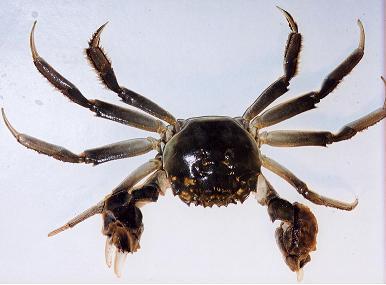Chinese Mitten Crab
Eriocheir sinensis
Report it
If you think you have found an aquatic invasive species:
- do not return the species to the water
- take photos
- note:
- the exact location (GPS coordinates)
- the observation date
- identifying features
- contact us to report it
Identifying features
- Adult size: 3 to 10 cm;
- Colour: greenish brown;
- Shell with a notch between the eyes and four spines on either sides;
- Two claws of the same size with white tips and dense fluffy hair (the adults seem to be wearing mittens);
- Legs twice as long as the carapace width.
Similar species (native)
No native species have hairy claws.
Where it has been found
It was first reported in the Great Lakes in 1965 where it occasionally shows up in Lakes Ontario and Erie. It appeared in the St. Lawrence River in 2004. No freshwater crab species existed in North America before its arrival. The Chinese Mitten Crab was first discovered on the west coast of California in 1992, indicating that they could possibly spread to B.C. waters via coastal commercial shipping activities.
Habitat
The Chinese Mitten Crab can be found down to a depth of ten meters, in fresh or brackish waters in estuaries, lakes, rivers and wetlands. It can tolerate a wide range of temperatures and salinities and can easily survive in disturbed and polluted environments. It is a catadromous species that lives in freshwater and reproduces in saltwater.
Ecological and economic impacts
This species poses a serious threat to freshwater and tidal ecosystems. Chinese Mitten Crab can eat salmon, trout and sturgeon eggs and may threaten successful spawning of these species. They also have been known to damage fish habitat by causing extensive river bank erosion via their burrowing activities.
Origins and mode of arrival
Native to the Yellow Sea between China and Korea.
Chinese Mitten Crab could be introduced into Canada accidentally through ballast water or intentionally through illegal live food imports as mitten crab is considered a delicacy in Asian cuisine. It is important to note that the importation of the Chinese Mitten Crab is illegal due to human health risks (the mitten crab is an intermediate host for the oriental lung fluke - a parasite - that can be passed to humans who consume it raw or undercooked).
Mode of dissemination
It is now largely accepted that the worldwide spread of the Chinese Mitten Crab was due to human-mediated activities and not the result of natural causes.
Spread
The most probable unintentional vector for the introduction and transfer of the Chinese Mitten Crab is the transport by ship ballast waters. Presumably the uptake of pelagic larval stages would be responsible for the spread of the species via ballast water.
Human activity
The most likely pathways are the active transport and voluntary release of mitten crabs into new habitats to provide a new human food source, and the accidental release of crabs via ship ballast water discharge.
Government action
Scientific research
Fisheries and Oceans Canada is studying the Chinese Mitten Crab population to improve its understanding of how it reacts and adapts to Canadian conditions.
For further information
- Canadian Science Advisory Secretariat (CSAS) Publications
- Identification Booklet of marine species in Eastern Canada
- Biological Synopsis of the Chinese Mitten Crab, Eriocheir sinensis
Canadian Manuscript Report of Fisheries and Aquatic Sciences 2812 - Fisheries and Oceans Canada - Risk Assessment for Chinese Mitten Crab (Eriocheir sinensis) in Canadian Waters (CSAS ResDocs - 2008/041)
Research document – 2008/041 – Fisheries and Oceans Canada
References
- Veilleux, E., and de Lafontaine, Y. 2007. Biological synopsis of the Chinese Mitten Crab (Eriocheir sinensis). Can. Manusc. Rep. Fish. Aquat. Sci.2812: vi + 45p.
- Date modified:


